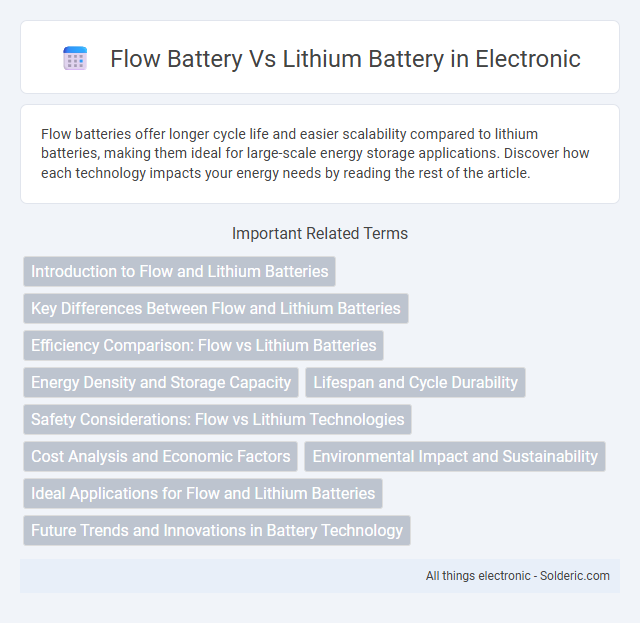Flow batteries offer longer cycle life and easier scalability compared to lithium batteries, making them ideal for large-scale energy storage applications. Discover how each technology impacts your energy needs by reading the rest of the article.
Comparison Table
| Feature | Flow Battery | Lithium Battery |
|---|---|---|
| Energy Storage Type | Electrochemical cell with liquid electrolyte tanks | Solid-state chemical storage |
| Energy Density | Lower (20-50 Wh/L) | Higher (100-265 Wh/kg) |
| Cycle Life | Over 10,000 cycles | Typically 500-2,000 cycles |
| Charge/Discharge Rate | Slower, suitable for steady output | Fast charging capability |
| Scalability | Highly scalable by increasing electrolyte volume | Limited by cell size and chemistry |
| Cost | Lower cost for large-scale storage | Higher upfront cost |
| Environmental Impact | Non-toxic, recyclable electrolytes | Uses rare metals, recycling challenges |
| Applications | Grid storage, renewable energy integration | Consumer electronics, EVs, portable devices |
Introduction to Flow and Lithium Batteries
Flow batteries store energy in liquid electrolytes separated by a membrane, enabling scalable and long-duration energy storage, ideal for grid applications. Lithium batteries rely on solid electrodes and liquid or gel electrolytes, offering high energy density and fast charge-discharge cycles suitable for portable electronics and electric vehicles. Each battery type presents distinct advantages in terms of scalability, cost, lifecycle, and application-specific performance.
Key Differences Between Flow and Lithium Batteries
Flow batteries utilize liquid electrolytes stored in external tanks, allowing for scalable energy capacity and long cycle life with minimal degradation. Lithium batteries rely on solid electrodes and operate with high energy density and fast charge rates but face limitations in lifespan and thermal management. Flow batteries excel in grid-scale energy storage with flexible scalability, whereas lithium batteries dominate portable electronics and electric vehicles due to compact size and high power output.
Efficiency Comparison: Flow vs Lithium Batteries
Flow batteries typically offer lower round-trip efficiency, around 65-75%, compared to lithium-ion batteries, which achieve efficiencies of 85-95%. Despite lower efficiency, flow batteries provide longer cycle life and superior scalability for large energy storage applications. Your choice depends on whether higher efficiency or extended durability and capacity are more critical for your energy system.
Energy Density and Storage Capacity
Flow batteries offer lower energy density compared to lithium batteries, making them less suitable for compact applications but ideal for large-scale energy storage due to their scalable storage capacity. Lithium batteries provide high energy density, enabling longer runtime within smaller, lightweight designs, which is advantageous for portable electronics and electric vehicles. Your choice depends on whether you prioritize space-saving energy density or flexible, large-volume storage capacity.
Lifespan and Cycle Durability
Flow batteries offer significantly longer lifespans and superior cycle durability compared to lithium batteries, often exceeding 10,000 cycles without substantial capacity loss. Lithium batteries typically provide 500 to 1,500 cycles before noticeable degradation, affecting your energy storage performance over time. Choosing a flow battery ensures enhanced longevity and consistent efficiency for long-term energy applications.
Safety Considerations: Flow vs Lithium Technologies
Flow batteries exhibit enhanced safety due to their use of non-flammable electrolytes and lower risk of thermal runaway compared to lithium-ion batteries, which are prone to overheating and catching fire under certain conditions. The liquid electrolyte in flow battery systems allows for safer scalability and easier thermal management, reducing the likelihood of catastrophic failure. Lithium battery safety relies heavily on advanced battery management systems to prevent short circuits, overheating, and potential explosions during charge or discharge cycles.
Cost Analysis and Economic Factors
Flow batteries offer lower long-term costs due to their scalable design and longer cycle life, reducing replacement frequency compared to lithium batteries. Lithium batteries have higher upfront costs driven by expensive raw materials like cobalt and lithium, but benefit from established manufacturing efficiencies and widespread availability. Economic factors favor flow batteries in large-scale energy storage applications with high cycle demands, while lithium remains cost-effective for portable and short-duration use cases.
Environmental Impact and Sustainability
Flow batteries offer superior environmental sustainability due to their longer lifespan, recyclable electrolytes, and reduced toxic material content compared to lithium batteries. Lithium batteries involve extensive mining of scarce metals like cobalt and lithium, causing significant ecological disruption and disposal challenges. You can enhance your energy storage system's eco-friendliness by choosing flow batteries, which provide safer, more sustainable alternatives with less environmental degradation.
Ideal Applications for Flow and Lithium Batteries
Flow batteries are ideal for large-scale energy storage applications such as grid stabilization and renewable energy integration due to their long cycle life and scalability. Lithium batteries excel in portable electronics, electric vehicles, and residential energy storage thanks to their high energy density and fast charging capabilities. Understanding your specific energy demands can help determine whether a flow or lithium battery best suits your application needs.
Future Trends and Innovations in Battery Technology
Flow batteries offer scalable energy storage solutions with extended cycle life and rapid response times, making them ideal for grid-level applications and renewable energy integration. Lithium batteries continue to dominate portable electronics and electric vehicles with innovations improving energy density, charging speed, and cost reduction through solid-state electrolytes and silicon-anode advancements. Future trends emphasize hybrid systems combining flow and lithium technologies, enhancing overall efficiency, durability, and sustainability in next-generation energy storage.
Flow battery vs Lithium battery Infographic

 solderic.com
solderic.com